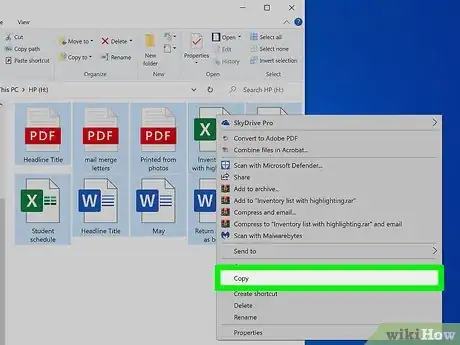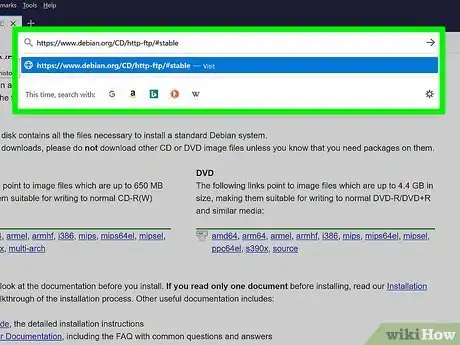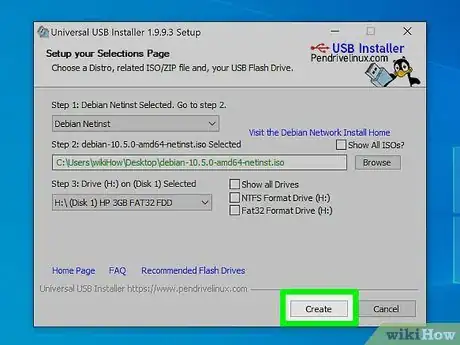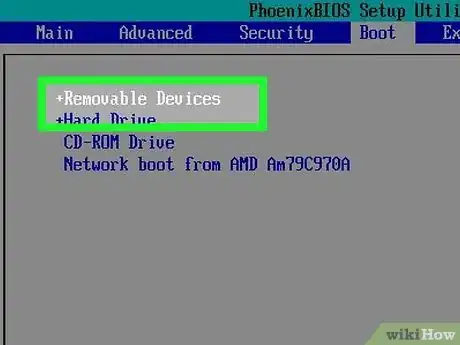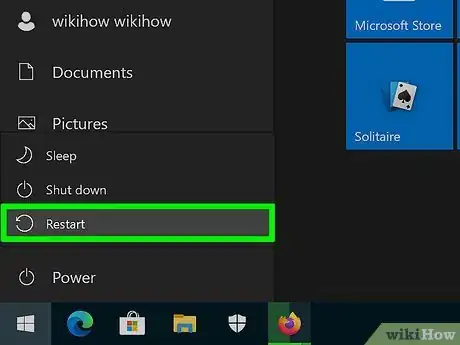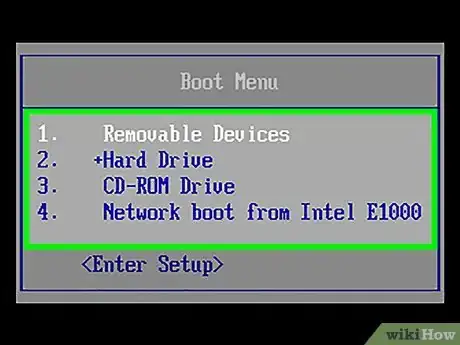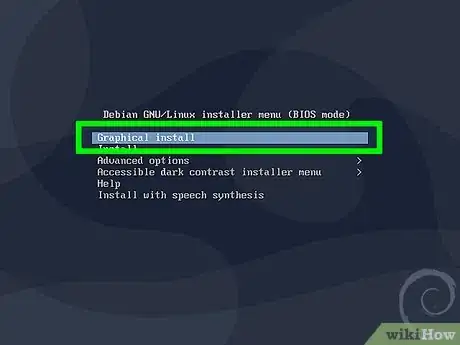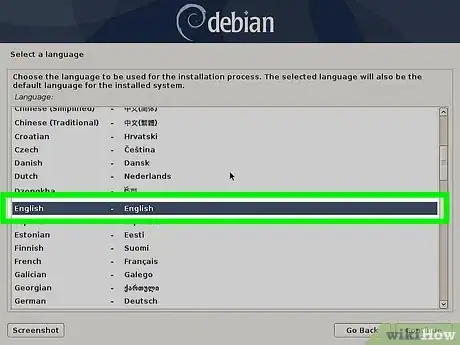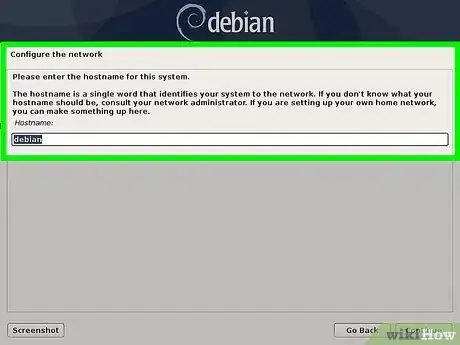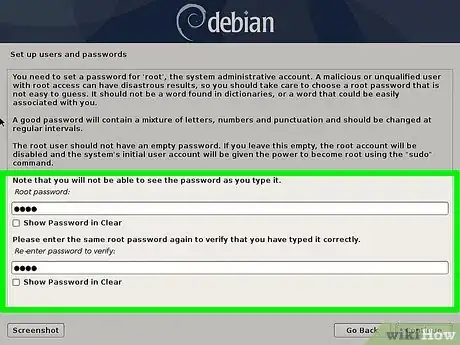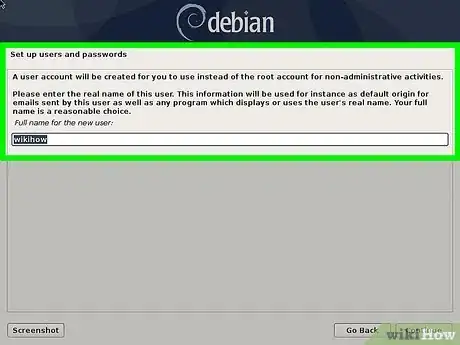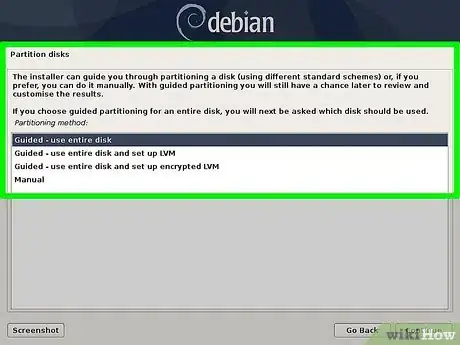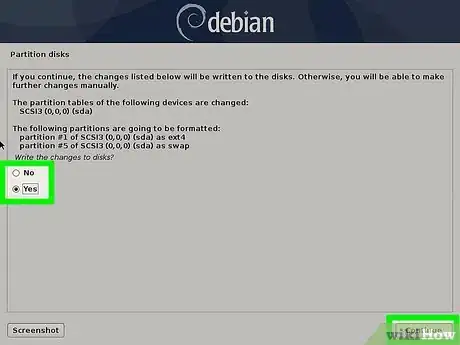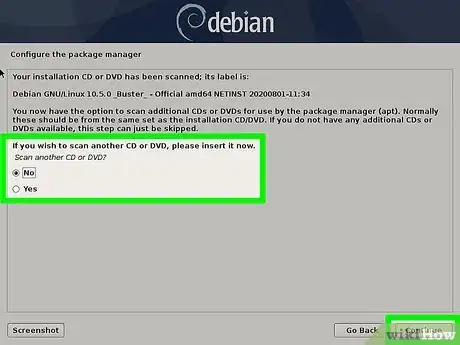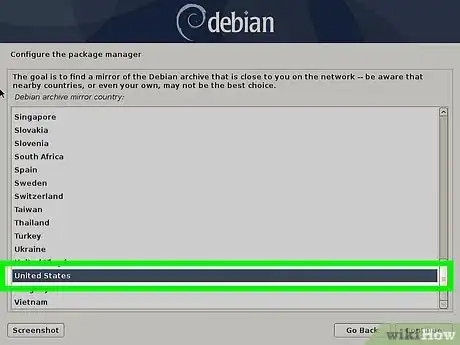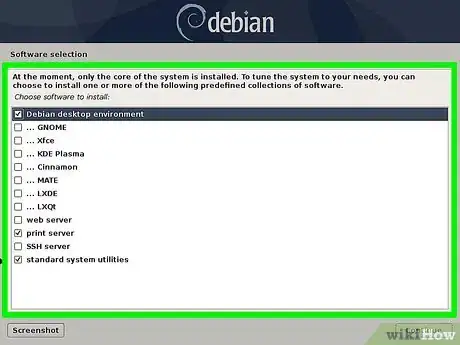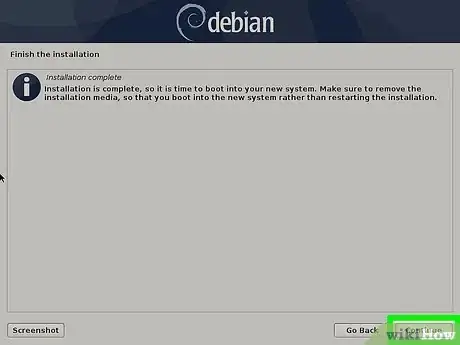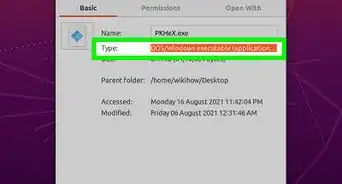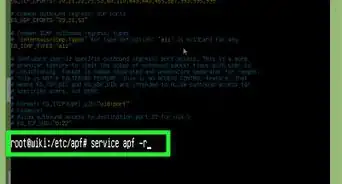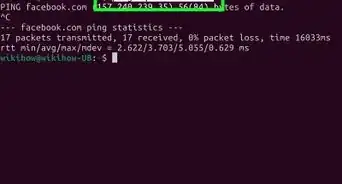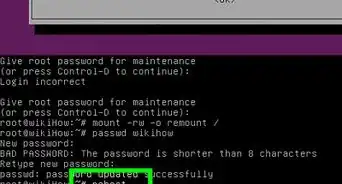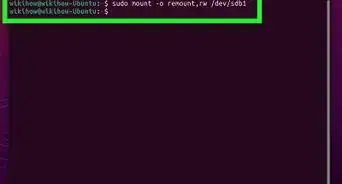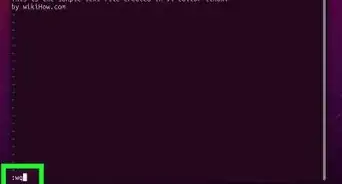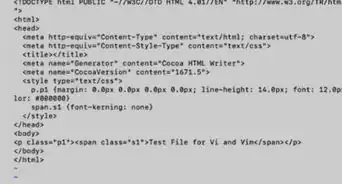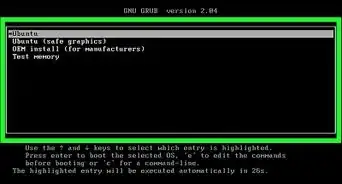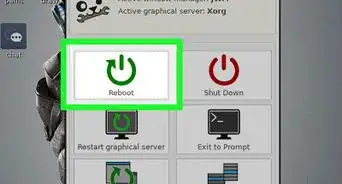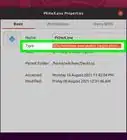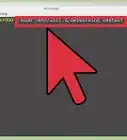This article was co-authored by wikiHow staff writer, Nicole Levine, MFA. Nicole Levine is a Technology Writer and Editor for wikiHow. She has more than 20 years of experience creating technical documentation and leading support teams at major web hosting and software companies. Nicole also holds an MFA in Creative Writing from Portland State University and teaches composition, fiction-writing, and zine-making at various institutions.
This article has been viewed 169,120 times.
Learn more...
This wikiHow teaches you how to install the latest version of Debian Linux on your PC. Debian, like most other Linux distributions, is a free and open source operating system for both desktop and server use, spawning several notable offshoots such as the Ubuntu operating system. Learning how to install Debian is a relatively straightforward process requiring just an Internet connection, disk imaging software, and a blank USB stick.
Steps
Creating an Installation Drive or Disc
-
1Back up any important files on your computer. Whether you plan to wipe out another operating system (such as Windows) and replace it with Debian or you want to set up a dual-boot situation, back up any existing data just in case something goes wrong.[1]
- These steps will work best if you're using Windows 10 or 8.1 on the PC already, whether you plan to keep Windows installed or not.
- If you're going to dual-boot Debian with Windows or another operating system, make sure you have that operating system's installation or recovery media in case you ever need to reinstall it.[2]
-
2Back up the contents of your USB flash drive. You can copy the Debian installation image to a USB drive and use it to install Debian. Since the drive will need to be bootable, everything on it now will be formatted and erased before you install Debian—make sure to save any files you wish to keep.
- Your USB drive should be at least 2 GB so there's enough room for the CD installer.
- If you'd rather install Debian from a bootable CD-R, you can do that instead. We'll focus on USB drives as not too many PCs come with optical drives anymore.
Advertisement -
3Download a Debian image from https://www.debian.org/CD/http-ftp/#stable. Debian 10 offers a variety of installation media for different platforms. Download the image you know you need, or use this info to get you started:
- Debian installers are based on your hardware. So, if you have a 64-bit PC with an Intel or AMD processor, select amd64 under the "CD" header. If you have a 64-bit system with an ARM processor, click arm64 instead. If you have a 32-bit system, click i386.
- In the resulting file list, click the file that ends with xfce-CD-1.iso to download the full ISO of the installer. Or, if you have speedy broadband (or higher) internet, you can select the one ending with netinst.iso to get a smaller file that requires an internet connection during installation.
-
4Create a bootable USB drive using the downloaded ISO file. This process is simple but requires installing some free software. See How to Make a USB Bootable to learn about using Rufus (for Windows) to flash the downloaded ISO file onto your USB drive.
- You can use Rufus and other similar software to create a bootable CD-R as well.
- If you're installing Debian on a virtual machine (like VirtualBox), you can skip this step—after creating your Debian virtual machine, you can mount the downloaded ISO as a virtual optical drive and boot from it.
-
5Configure your PC so that it can boot from a USB or optical drive. Now that you have your Debian installer ready to go, you'll need to make sure you can boot from it. This must be done in your PC's BIOS. All BIOS are different, but what you'll need to do is find the section labeled "Boot Order" (it will be a list of drives connected to your computer) and move the USB controller (or the optical drive) to the top of the list. Getting to the BIOS varies by system:
- If you're using Windows 10 or 8.1, you can usually enter the BIOS from the desktop:
- Click the Start menu and select Settings.
- Navigate to Update & Security > Recovery.
- Click Restart now under "Advanced startup."
- Click Troubleshoot when the PC comes back up.
- Go to Advanced options > UEFI Firmware Settings.
- You can also reboot your PC and quickly (and repeatedly) press the BIOS hotkey for your manufacturer. The hotkey appears on the first screen you see after rebooting near something like "Enter Setup." Some common hotkeys are F2 (Acer, Asus, Lenovo, Dell, Origin PC, Samsung, Sony, Toshiba), F1 (Lenovo desktops and ThinkPad models, Sony), F10 (HP), and the Del key (Acer, Asus, MSI).[3]
- If you're using Windows 10 or 8.1, you can usually enter the BIOS from the desktop:
Installing Debian
-
1Insert your bootable USB install drive and reboot your PC. If you created an installation CD-R, insert that instead.
-
2Select the option to boot from USB or CD-ROM drive when prompted. This option appears once you reboot the PC. The PC will then boot into the first installation screen.
-
3Select Graphical Installer. Use the arrow key to make the selection, and then press the Enter key to select it.
-
4Select a language and region. The first three screens will ask you to choose your language, location, and keyboard region. Once you've made your selections, the installer will ask you to configure your network.
-
5Enter the requested network information. This will look different depending on how you're installing Debian (full CD image or over the network).
- In both cases, you'll be asked to enter a hostname and domain name. The domain name can be left blank if your local network doesn't require it.
- If you're installing over the internet (this is the case if you downloaded the smaller ISO file), you'll also be walked through instructions on connecting your PC to the internet. If you receive an error about your Wi-Fi adapter, use an ethernet cable in the meantime.
-
6Create (or skip) a root password. Although it was once required to create a root (admin) account and password when installing Debian, you can now skip this step.[4] Skipping the root password step means sudo will automatically be set up for your user account—this will give you administrative access. It's actually safer to not have a root password since you won't need to share a root password with other admins. You can then just elevate other accounts that also need administrative access.
- To skip creating a root password, leave the "Set up users and passwords" screen blank and click Continue.
- If you create a root password now, you won't have sudo access set up immediately, which means you'll need to use "su root" every time you want to do something administrative rather than "sudo." But if you do want to create a root password, you can do so and then install the sudo package later.
-
7Create a user account. Now you can create your personal account, which is how you'll log in to Debian. On the next several screens:
- Enter your full name and click Continue.
- Type a username (all lowercase letters, but you can also use numbers if you'd like) and click Continue.
- Enter and confirm a secure password, and then click Continue. As long as you skipped adding a root account, this new account will be given sudo rights.
-
8Select your time zone and click Continue. This ensures your system clock is set properly.
-
9Select a partition option. The option you choose for partitioning depends on your needs:
- If you just want to install Debian on existing unused drive space, select Guided – use the largest continuous free space.
- If you want only want to use Debian on this drive and not anything else, select Guided – use entire disk.
- Select Manual if you want to retain other partitions on the computer, such as your Windows installation.
-
10Follow the on-screen instructions to partition your drive(s). This process varies depending on how you're installing Debian. If you chose one of the Guided options, let the on-screen instructions walk you through the process. When given the option to choose a file system, select Ext4 journaling file system. When the partitioning is complete, Debian will start installing.
-
11Select "No" when asked to scan another CD/DVD and click Continue. This pops up after Debian is already partially installed.
-
12Choose a network mirror and select Continue. When asked if you'd like to use a network mirror to complete the installation, you can opt to do so.
- Select No to continue the installation from the downloaded image.
- Select Yes if you'd like to finish the installation over the internet, and then follow the on-screen instructions to set up your network preferences.
-
13Select software to install and click Continue. Make sure to select at least once desktop environment, such as GNOME or KDE, as well as the option for "standard system utilities." If you want to be able to connect to your Debian system remotely through SSH, select the "SSH server" option.
- Any software you install can be updated at any time later.
- Once you click Continue, Debian will begin the bulk of the installation process.
-
14Click Continue when the installation is complete. It can take several minutes for this to appear, depending on the speed of your computer (and network speed, if you installed over the internet). This will immediately reboot the computer into the GRUB bootloader.
-
15Select Debian GNU/Linux to boot into Debian. It should be the first option. The GRUB bootloader was installed with Debian and will come up any time the computer is rebooted. Once you select this option, you'll be brought to the Debian login screen. Congratulations, you've installed Debian!
- If you have Windows installed and wanted to boot into it instead, choose Windows Boot Manager.
- To access your system BIOS from Grub, choose the System setup option.
Community Q&A
-
QuestionCan Android phones use Debian?
 Community AnswerNo. The Android operating system is a version of Linux, but it is designed specifically for mobile phones. Debian, on the other hand, is made for desktop PCs and laptops, and can not handle the inputs and outputs of a smartphone.
Community AnswerNo. The Android operating system is a version of Linux, but it is designed specifically for mobile phones. Debian, on the other hand, is made for desktop PCs and laptops, and can not handle the inputs and outputs of a smartphone. -
QuestionHow do you recover the backup from Windows onto the new Debian OS?
 PythonmegapixelCommunity AnswerIf you backed up your files to an external storage device, then simply connect it to the computer and copy the files into your home directory.
PythonmegapixelCommunity AnswerIf you backed up your files to an external storage device, then simply connect it to the computer and copy the files into your home directory. -
QuestionHow do you recover the backup from Windows onto the new Debian OS?
 A_random_readerCommunity AnswerIf you have backed up by copying the files, you can just plug the flash drive in and hope for the best that your files are ready to be copied. Linux cannot handle Windows backups, in which case you will have to browse the backup and manually copy the files back.
A_random_readerCommunity AnswerIf you have backed up by copying the files, you can just plug the flash drive in and hope for the best that your files are ready to be copied. Linux cannot handle Windows backups, in which case you will have to browse the backup and manually copy the files back.
References
About This Article
1. Download an official Debian installer ISO from Debian.org.
2. Create a bootable USB drive or CD-R from the ISO.
3. Boot from the USB drive or CD-R.
4. Select Graphical installation.
5. Follow the on-screen instructions to install.

